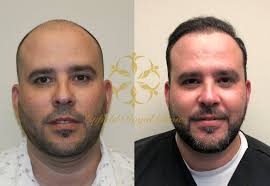The Step-by-Step Process of Hair Transplant Surgery
Process of Hair Transplant Surgery, Male Hair Transplant In Abu Dhabi is a meticulously planned and executed procedure designed to restore natural hair growth in areas affected by baldness or hair loss. Understanding the step-by-step process of hair transplant surgery can help individuals prepare for the procedure and achieve optimal results. In this guide, we outline the comprehensive steps involved in hair transplant surgery, from initial consultation to post-operative care.

Step 1: Consultation and Assessment
The hair transplant process begins with a thorough consultation with a qualified hair transplant surgeon. During the consultation, the surgeon evaluates the patient’s scalp condition, hair loss pattern, donor hair availability, and overall candidacy for the procedure. The surgeon works closely with the patient to establish realistic expectations, discuss treatment options, and develop a personalized treatment plan tailored to their needs and goals.
Step 2: Preoperative Preparation
Before the surgery, patients may be instructed to follow specific preoperative instructions to optimize their candidacy and ensure a successful procedure. These instructions may include avoiding blood-thinning medications, alcohol, and smoking in the days leading up to the surgery. Patients are also advised to wash their hair with a medicated shampoo to minimize the risk of infection and promote scalp hygiene.
Step 3: Anesthesia Administration
On the day of the surgery, the patient is positioned comfortably in the surgical chair, and local anesthesia is administered to numb the donor and recipient areas of the scalp. The use of local anesthesia ensures that the patient remains awake and comfortable throughout the procedure while minimizing any discomfort or pain.
Step 4: Donor Hair Harvesting
Once the anesthesia takes effect, the surgeon begins the process of harvesting donor hair follicles from the back or sides of the scalp. Depending on the chosen technique, such as follicular unit transplantation (FUT) or follicular unit extraction (FUE), donor hair follicles are either surgically removed as a strip of tissue (FUT) or individually extracted using a specialized punch tool (FUE). The harvested follicles are carefully preserved and prepared for transplantation.
Step 5: Recipient Site Preparation
Simultaneously, the surgeon prepares the recipient sites on the balding or thinning areas of the scalp where the hair follicles will be transplanted.
Using precise techniques and instruments, the surgeon creates tiny incisions or slits in the scalp, following the natural hairline and pattern, to accommodate the transplanted follicles. The density, angle, and direction of the recipient sites are meticulously planned to achieve natural-looking results.
Step 6: Hair Follicle Transplantation
With the donor hair follicles harvested and the recipient sites prepared, the surgeon begins the process of transplanting the follicles into the recipient sites.
Using specialized instruments, the surgeon carefully inserts each follicular unit into the recipient sites, ensuring proper alignment and orientation for optimal growth. The transplantation process is performed meticulously, with attention to detail to achieve a natural-looking hairline and density.
Step 7: Postoperative Care and Recovery
After the transplantation process is complete, the patient is provided with postoperative care instructions and guidance for a smooth recovery. Patients may experience minor discomfort, swelling, and redness in the days following the surgery, which can be managed with prescribed medications and proper care.
It’s essential to follow the surgeon’s instructions regarding postoperative care, including avoiding strenuous activities, protecting the scalp from sun exposure, and attending follow-up appointments for monitoring and assessment.
Step 8: Results and Follow-Up
Over the following weeks and months, transplanted hair follicles gradually take root and begin to grow in their new location. Patients can expect to see noticeable improvements in hair density and appearance as the transplanted hair matures and thickens.
Follow-up appointments with the surgeon allow for ongoing evaluation of the results and any necessary adjustments or additional treatments to optimize outcomes.
Conclusion
Hair transplant surgery is a highly specialized procedure that involves multiple steps, from initial consultation to postoperative care and follow-up. By understanding the step-by-step process of hair transplant surgery, individuals can make informed decisions, prepare adequately, and achieve optimal results with their hair restoration journey.
